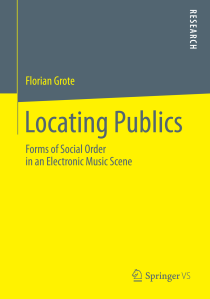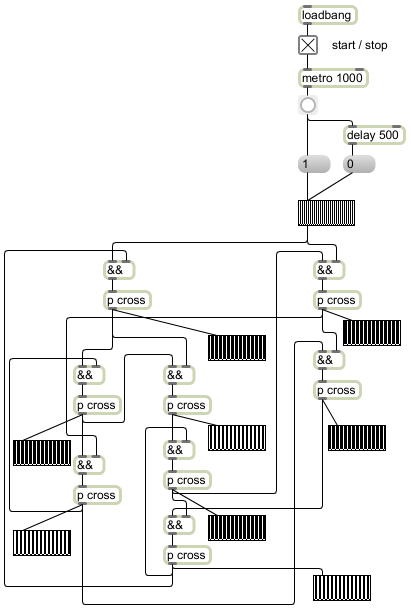My commentary on Manfred Füllsack’s excellent article “The Circular Conditions of Second-order Science Sporadically Illustrated with Agent-based Experiments at the Roots of Observation” was published today in Constructivist Foundations’ special issue on Second Order Science. It is the journal’s tenth volume already, which is a great achievement. The commentary argues that the rise in entropy the article is postulating for systems of second-order observation is actually good for something, in that it adds to possible courses of action for participants in these systems, which equals to directly feeding into situations of double contingency. In short, more entropy means more possibilities to act (more degrees of freedom) for all participants in communication, thus ensuring that double contingency is maintained and communication is kept alive.
Full text (Pdf)
Category Archives: Science
ESA-Arts Paper: Jamming with Machines
The European Research Network Sociology of the Arts held its 8th midterm conference at Cluj / Romania from September 4-6, 2014. I had the honor to present a paper on the current state and the outlook of research conducted within the GiantSteps research project, focusing on prospects and problems of so-called “musical expert agents” in creative processes. The paper discusses a situation where the availability of large amounts of data on artistic work facilitates new approaches in composition and sound creation. What are the expectations towards these new possibilities? Are artists looking forward to algorithmic “agents”, or will they disable them immediately?
Full paper
ESA-Arts 2014 Conference Website
GiantSteps Project
Book publication “Locating Publics”
The book publication of my dissertation “Locating Publics: Forms of Social Order in an Electronic Music Scene” is now available from Springer VS. The table of contents and a full sample chapter can be downloaded from here:
Book page
NeuronVS now free
Although the Neuron Synthesizer was and still is a flagship synth that stood for innovation in the field of Resynthesis, it was not a commercially successful product. After the hardware version, the creators also released a software plug-in based on the same engine. The unique approach in this engine is that concrete material, such as a user’s own samples, can be fed into the engine, which then creates an abstract semantic model from it and uses its own sound-generating means to recreate the original sound. The model is rather complex and includes many parameters in both timbre and temporal development of the sound. It is interesting as an example of a bold abstraction process, transforming sound to the symbolic level, while retaining much of its information. The engine then allows the user to go beyond the more or less faithful recreation of an original sound, and work with the parameters of the model – musically the much more interesting part. The NeuronVS software part is now available for free for Mac OS.
Zeppelin University Research Day
Zeppelin University in Friedrichshafen will hold another Research Day on January 25. This is a great opportunity for members of the interested public to get an insight into research projects currently in the works. I will have the opportunity to present some of my communication research into cultural networks at the event.
New blog: Social Observers
I started a new blog to discuss distinction analysis and cognitive processes of communication. It is dedicated to the question of how society observes, and I intend to bring together theoretical considerations and analyses of concrete phenomena.
The blog is at http://www.socialobservers.com.
Dynamics of “Vivisystems”
Although Kevin Kelly’s famous book “Out of Control” was published back in 1994, it still holds plenty of topics that are worth to be brought to the table in all different kinds of discourses on systems. In addition, it provides a broad spectrum of ideas for computer models of complex systems. The author has kindly made the full book available for free on his website.
Book page
Strangely enough, although the author describes the benefits of biological and technological coevolution, he then ventures to favor technological taking over biological evolution by means of genetic and bioengineering. This is where I’d disagree, as it seems illogical, especially in the context of the book itself, to deliberately give up biological assets such as proven sustainability in conjunction with emergence, and fallback mechanisms that can help minimize risk for all parties involved.
HyperKult 19: Mobiles – You Are Now Here
Already in it’s 19th incarnation, the annual HyperKult workshop & conference takes a fresh look at the topic of location-based applications for mobile devices. While this issue has been drifting around social sciences conferences for years, we are just now seeing widespread adoption of such applications and services, which should allow us to change the mode of discussion from utopia to concrete social practice.
As always, video streams of the full presentations will be available both live and in the archive.
Conference Website (in German)
Laws of Form, Chapter 11 Example Programs
In chapter 11 of his Laws of Form, George Spencer Brown offers the notion of circuits as a way to interpret his calculus. He gives a few examples (p55 in the 2008 edition). Using Max/MSP as the programming environment, it is rather simple to reproduce these circuits. There are two different circuits in the chapter, both of which essentially do the same thing: divide the frequency of a pulse by two.
Download the example programs (Mac OS / Windows)
The circuit is built so that variable a changes between the marked and the unmarked state. The first example corresponds to arrangement E4 in chapter 11, while the second example operates with the imaginary state, thereby simplyfying the circuit. In the 2008 edition of the Laws of Form, Spencer Brown points out that the circuit can also work with four connections less than in the illustration, and asks the reader to find out which connections can be left out. The third example program presents a possible solution to this challenge.
Finally, the fourth example program is even simpler, with fewer connections than the other examples. However, this program seems to work profoundly different than Spencer Brown’s examples, and it does not keep the calculation’s phase as they do.
Detecting Upcoming Tipping Points?
Wired Magazine has a story on an intriguing advancement in natural sciences: The possibility that research may be drawing closer to an understanding of critical thresholds, so-called tipping points, that seem like part of a continuum in passing, yet with hindsight can be identified as key indicators of the starting of a new direction for a process. Examples include dramatic climate changes after longer, steady developments, as well as index behaviors in stock markets. With Heinz von Foerster, it could be speculated that these critical thresholds mark the overtaking of a process by a new “Eigen-Value”, a distinctive value determining the development of the process. If indeed such Eigen-Values exist for a number of very different processes, then could it be possible that new Eigen-Values are foreseeable by recognizable changes in patterns within the process, as Steve Carpenter and his team at the University of Wisconsin suspect?
Full article



